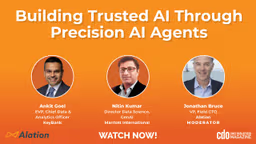Opinion & Analysis
How to Make GenAI Dependable, Not Just Intelligent
Written by: Pritam Bordoloi
Updated 7:00 PM UTC, Tue August 26, 2025

In the rapidly evolving world of AI, success isn’t just about building the smartest models, it’s about turning them into scalable, trusted, and impactful products. Anil Pantangi, AI & Analytics Solutions Delivery Lead at Capegemini, understands this well.
Pantangi is a product and technology expert with over 15 years of experience currently helps organizations navigate the hardest challenges in enterprise AI: data fragmentation, scaling beyond proofs-of-concept, aligning cross-functional teams, and ensuring systems are not only powerful but also explainable, fair, and trusted.
In this conversation, Pantangi shares his perspective on what it takes to productize AI at scale, how enterprises can move from experimentation to value, and why governance, data readiness, and user trust are the foundational pillars.
Edited Excerpts:
Q: Your background spans multiple tech organizations. How has this shaped your perspective on scaling AI-powered products across global enterprises?
The scale does not simply result from technology but from how you operationalize that intelligence across the enterprise. At Amazon, I observed how telemetry, feedback loops, and customer signals were used for both optimization and rapid iteration.
At Capgemini, I applied similar principles to enterprises challenged by legacy infrastructure and global complexity, where I created hub-and-spoke operating models, reimagined enterprise workflows, and developed talent to own AI outcomes, not just tools. The goal has always been the same: AI is part of the decision-making process, and AI is built to iterate.
Q: Many enterprises struggle to scale AI beyond pilots — it becomes a graveyard of proofs-of-concept. From your experience, what are the common pitfalls, and what does it take to design an AI program that goes from experimentation to real, sustained impact?
The biggest error people make is chasing technical novelty and losing sight of how they will solve a system-level problem. Pilots are typically run in a vacuum, with no plan for how to integrate them into a system, fund them, govern them, or own the outcomes. The way to break that cycle is to tie every experiment to an outcome that matters, whether that is a faster decision, a cost reduction, or frontline enablement, and to factor in telemetry and governance from the beginning. In several of the programs I work on, I serve as the liaison between business, data, and engineering to facilitate the seamless transition from prototype to product.
Q: Many teams jump into GenAI with excitement but little discipline. What’s your approach to identifying GenAI use cases that deliver real business value — and what’s one that made you say, ‘This is why it matters’?
The most impactful GenAI use cases are not the ones that wow people in a demo; they are the ones that remove friction in the right places. One of the most gratifying projects we undertook was in field operations support, where we trained a GenAI assistant using transcripts, policies, and real-time service data.
It enabled frontline employees to access instant, contextual answers rather than having to search through documents or wait for support. It was not so much about automating a decision but about restoring time and focus to the people who are closest to the customer.
Q: You’ve seen AI deployed across industries — from telecom to retail. What’s a common trap leaders fall into when transferring AI strategies across domains, and how do you recommend approaching domain-specific nuances?
One major pitfall is assuming that the same signals and success criteria apply across domains. In the telecom industry, we have a rich source of real-time service telemetry. In retail, seasonality, promotions, and localized behaviors play a much larger role. Rather than applying an AI strategy as a template, I advise holding innovation sprints (some organizations that I partnered with call them vision-setting meetings) in each engagement, where we map signals, red flags, workflows, and other key elements to that industry’s specific cadence. What transfers well is the muscle of disciplined experimentation, feedback loops, and telemetry-supported measurement.
Q: Capgemini advises clients on digital transformation — but how does the firm itself stay on the cutting edge? What does internal transformation look like at a consultancy that’s also driving change externally?
Capgemini applies a similar discipline internally that is advised externally. For example, internal knowledge management, learning and development, and collaboration systems have all been reimagined using AI and modern enterprise architecture. We measure usage, sentiment, and outcome quality to tune these systems continuously.
Q: Looking ahead, what’s a looming AI or data challenge you think most enterprises are underestimating today — and how should they start preparing before it becomes urgent?
One of the most underestimated challenges is managing the indeterminism that naturally comes with modern AI systems, especially those powered by foundation models or probabilistic learning.
Input into a modern AI system does not necessarily return the same output as traditional software. Even though deliberate processes can be referenced in success metrics, this unpredictability could generate friction in enterprise scenarios where consistency, auditability, and ultimately trust are mission-critical.
To manage this, observability and control should be treated as first-class design principles. We start by instrumenting models with telemetry, not just output but confidence, variability, and context. We design AI workflows to enable human feedback, provide fallback paths, and include override controls.
In customer-facing or HR systems, we include explanation layers and logging that help reconstruct the model’s behavior at the time of decision.
We also apply runtime governance to GenAI pipelines, including version management and automatic flagging of drift or hallucination-prone behavior.
These are not just technical guardrails; they’re also cultural ones. They help shift AI from a black box to a co-pilot that teams can rely on, improve, and question when needed. Tackling indeterminism head-on through system design, human-in-the-loop checkpoints, and structured feedback loops is how we make AI dependable, not just intelligent.





